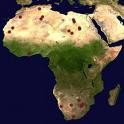Somalis Under Relentless Drone Attack as U.S. Tightens Military Grip on Continent

Scores of Somali civilians have been killed in U.S. drone attacks in the southern region of the country, as Washington tightens its military grip on much of the continent. The current offensive involves thousands of Kenyan troops that are threatening the major Somali city of Kismayo. The American drones are supporting the Kenyan invasion. The drones’ origins are officially secret, but it is known that the U.S. operates drone bases in Ethiopia and Djibouti, which is home to a huge American base.
For all practical purposes, the U.S. has made proxies of Ethiopia and the five member states of the East African Community: Kenya, Uganda, Tanzania, Burundi and Rwanda. The Ugandans and Burundians safeguard the airport that is the lifeline for Somalia’s puppet regime in Mogadishu, where the CIA operates a major facility. In September, the militaries of the East African Community held joint exercises with AFRICOM, the U.S. Africa Command.
Such exercises with American forces have become commonplace. The U.S. Defence Department is busily training the militaries of Mali, Chad, Niger, Benin, Botswana, Cameroon, the Central African Republic, Ethiopia, Gabon, Zambia, Uganda, Senegal, Mozambique, Ghana, Malawi and Mauretania. ECOWAS, the Economic Community of West African States, is considering asking the U.S. navy to help it out with its pirate problem. Most of the militaries of the African Union already communicate with American command-and-control equipment, requiring U.S. advisors. The overlapping entanglements have allowed the U.S. military to achieve deep penetration of the armed forces of most African nations.
In such a web of dependency, few standing African armies are capable of defending themselves if the aggressor is the United States. But in most cases, the U.S. would likely get its way without a fight, since the officer class of so many African militaries have direct ties with their American counterparts. The U.S. has so thoroughly infiltrated African armies, many, if not most, would be of no use for national defence against the Americans.
The Americans are almost everywhere, but the French never left Africa. Although France and the U.S. were long-time rivals in Africa, waging proxy wars against each other through their African flunkies, their joint actions against Haiti and Libya, and in bringing down the government in the Ivory Coast, signal that the French and Americans are full partners in neo-colonialism.
Now President Obama has officially sent 100 U.S. Special Forces troops to Uganda and neighbouring countries, ostensibly to track down a rebel force. They will also operate in the new nation of South Sudan.
Meanwhile, the NATO attack on Libya threatens to set the whole northern tier of Africa ablaze, a pretext for further U.S. and French operations. American penetration of Africa has reached the point that any nation “such as Eritrea “that does not have a military relationship with the United States is marked for regime change. Instead of the pan-Africanist dream of a United States of Africa, we are seeing an Africa under the military thumb of the United States.
Glen Ford is executive director of Black Agenda Report

